Analysis of soluble tlr7 in human-derived sample
- Summary
- Abstract
- Description
- Claims
- Application Information
AI Technical Summary
Benefits of technology
Problems solved by technology
Method used
Image
Examples
examples
[0114]The present invention will be described in more detail with reference to specific experiment examples; however, the present invention is not limited to the experiment examples below. Herein, concentrations and so on are based on weight, and numerical ranges shown are intended to include the endpoints, unless specifically stated.
experiment 1
of Anti-hTLR7 Antibody
[0115](1) Vector Construction and Establishment of hTLR7-Expressing Cells
[0116]Into a retroviral vector (pMXs) in which six Flag-His tags had been added to the C-terminal side of the gene, a hTLR7 gene (full-length, a gene encoding the amino acid sequence represented by SEQ ID NO: 17) was incorporated by using an In Fusion enzyme (Takara Bio Inc.). This retroviral vector was transfected into a packaging cell line (Plat-E, derived from HEK293 cells) by using a transfection reagent (Fugene 6, F. Hoffmann-La Roche Ltd.). After 24 hours, the culture supernatant was collected for use as a virus suspension. This virus suspension was mixed well with a liposomal transfection reagent (DOTAP, F. Hoffmann-La Roche Ltd.) and the mixture was added to the target cells, and centrifugal treatment was performed at 2000 rpm for 1 hour. The retroviral vector and the packaging cell line were given by Professor KITAMURA Toshio at The Institute of Medical Science, The University of ...
experiment 2
Evaluation for Monoclonal Antibodies Through Flow Cytometry
[0121]A Ba / F3 cell line forcedly expressing hTLR7-Flag-Hisx6 / hUnc93B1-HAx2, monkey TLR7, or mouse TLR7 was subjected to cell membrane permeabilization using 0.1% saponin solution, and stained with rE3 or LTM3. For evaluation of binding of each antibody, analysis was performed through flow cytometry and histograms were compared with those for staining of non-expressing cells. The results showed that rE3 and LTM3 exhibited cross-activity not only to human TLR7 but also to monkey TLR7, but did not show cross-activity to mouse TLR7 (FIG. 2).
PUM
| Property | Measurement | Unit |
|---|---|---|
| Nanoscale particle size | aaaaa | aaaaa |
| Nanoscale particle size | aaaaa | aaaaa |
| Nanoscale particle size | aaaaa | aaaaa |
Abstract
Description
Claims
Application Information
 Login to View More
Login to View More - R&D
- Intellectual Property
- Life Sciences
- Materials
- Tech Scout
- Unparalleled Data Quality
- Higher Quality Content
- 60% Fewer Hallucinations
Browse by: Latest US Patents, China's latest patents, Technical Efficacy Thesaurus, Application Domain, Technology Topic, Popular Technical Reports.
© 2025 PatSnap. All rights reserved.Legal|Privacy policy|Modern Slavery Act Transparency Statement|Sitemap|About US| Contact US: help@patsnap.com



